

Geusseppe Gonzalez
Public Sector


Rodrigo Serrallonga Mejía
Artificial Intelligence


Two key Latin American countries have demonstrated a strong interest in expanding broadband coverage, fostering investment, and maintaining industry dynamism. On 18 November, Peru’s Ministry of Transport and Communications (MTC) began the reorganisation of the 800 MHz band, seeking to increase the spectrum available for IMT use. On 21 November, Brazil’s national authority for telecommunications – Anatel – approved the Strategic Plan 2023-2027. This plan details Brazil’s regulatory roadmap, sets the connectivity objectives, and identifies focus areas for the South American pacesetter, which held the biggest auction in Latin America back in December 2021.
MTC issued Directorial Resolution 424-2022-MTC/27,[1] detailing the timeline for the reorganisation of the frequencies between 806-821 MHz, 851-866 MHz, 821-824 MHz, and 866-869 MHz, which are collectively referred to as the 800 MHz band. On the Resolution, Peru’s telecoms authority has established a timeline consisting of six phases, which will begin on 19 January 2023 and end on 7 June 2023 with the issue of an official Resolution.
The motivation behind this decision is to increase efficiency in the band, promote contiguous blocks of spectrum for LTE, and maximise spectrum availability for mobile or fixed services in bands below 1 GHz (lower bands), which are known for their coverage performance, particularly in rural contexts. In addition, this decision reiterates the spectrum cap of 60 MHz applicable to such bands and highlights the rights and duties of current concession holders.
The plan[2] approved by Anatel demonstrates the eagerness of increasing the adoption of new technologies while seeking to consolidate connectivity across Brazil, which aims to establish itself as a member of the Digital G20.
The plan contains four key areas: (i) promote connectivity, (ii) stimulate market dynamics, (iii) foster digital transformation of society while preserving market balance, and (iv) obtain excellent performance with tangible social results.
The document outlines ambitious connectivity goals, aiming to increase both coverage and adoption of 5G so that it reaches at least 57% of the population by 2027. This will be achieved by promoting satellite communications for remote and underserved areas, expanding fibre-optic connectivity in all municipalities, and increasing fibre-optic backhaul in at least 50% of locations with more than 600 inhabitants, among others. In addition, the regulator will promote innovation across different stakeholders, user rights protection, and digital transformation across society.
These developments demonstrate steady dynamism in two of the biggest countries in the region and evidence that connectivity will be a top priority regionally, even if these countries face very different challenges ahead.
In the case of Peru, the reorganisation of the 800 MHz band adds fuel to the promise of a spectrum auction that will promote the consolidation of 4G and the adoption of 5G. It is expected that the 800 MHz band would be added to the 2,300 MHz and AWS-3 (1.7-2.1 GHz) bands so that mobile operators find more attractive options for their LTE spectrum roster. Concerns will likely remain regarding the conditions for the auction, which now seems bigger than the one suspended in 2021.
For Brazil, even if there are doubts regarding the fulfilment of coverage obligations derived from the spectrum auction held in 2021, all 26 state capitals and Brasilia now have 5G coverage, making the country a regional pacesetter in terms of 5G rollout and adoption. In addition, Brazil’s biggest operators, Claro, Vivo, and TIM, seem to be well-placed for the future development of 5G use cases, making the country an attractive destination for emerging and new tech.
Regionally, 2023 seems to be a pivotal year for 5G, with Peru, Argentina, Colombia, and Uruguay expected to auction spectrum for 5G.
Access Partnership closely monitors tech, regulation, and policy developments in Latin America. For more information, please contact: Geusseppe Gonzalez at [email protected], Yamel Sarquis at [email protected], Rodrigo Serrallonga at [email protected], or Lucan Sanchez at [email protected].





